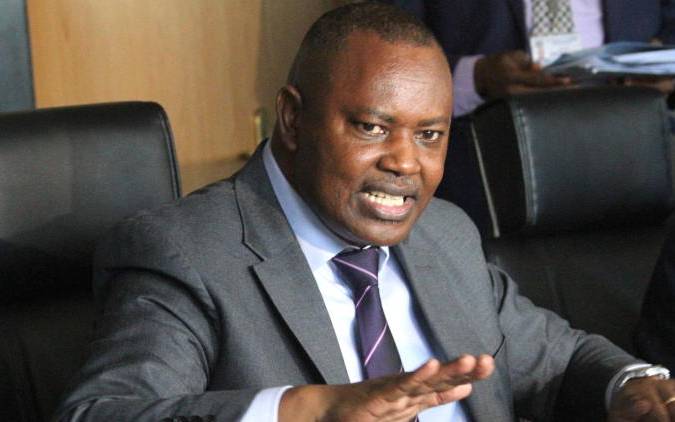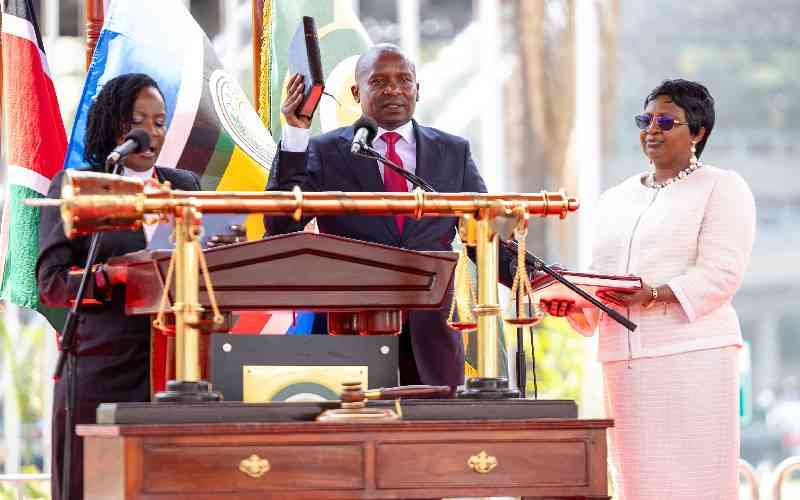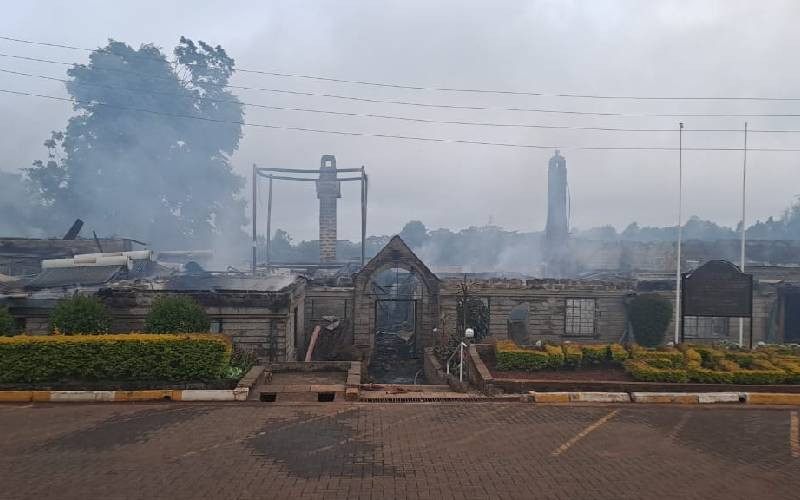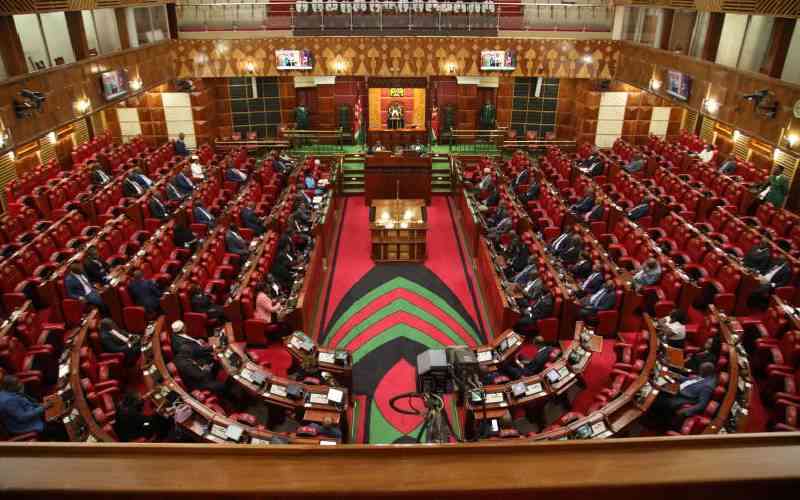
The police have put the Office of the Deputy President at the centre of an investigation into the death of Kipyegon Kenei.
At a press conference yesterday, Directorate of Criminal Investigations (DCI) boss George Kinoti (pictured) revealed the role that Kenei played in the fraudulent Sh39 billion arms tender that investigators believe led to his execution. The sergeant’s killers apparently feared he was about to spill the beans.
Key witness
“There is no doubt that that was a cold murder well-planned and executed. The motive of cold murder is very clear. It was simply to safeguard, protect, insulate and/or save the source from the adverse involvement and attendant consequences of using the country’s military procurement process in the most deceitful and fraudulent manner,” said Mr Kinoti.
Based on CCTV footage obtained from the ODP, Kinoti said Kenei was a key witness in the investigation into the fake arms deal as he is spotted guiding into the VIP lift one of the suspects who had posed as a Kenyan military general during negotiations with the foreign arms dealers.
Kenei was on the phone as they exited the lift on the second floor of Harambee House Annex, and he handed the phone to Daniel Otieno Omondi, aka General Juma, suggesting the person on the other end of the line discussed a matter that was known to the two.
“The involvement of the deceased in the complex activities of February 13, 2020, at Harambee House Annex clearly shows he didn’t have a chance. It is evident that throughout he was receiving instructions or orders or directions from a certain source. It is manifest that the stakes must be so high and adverse that it could be dangerous to expose the source,” Kinoti said.
The development raises several questions that the investigation will need to answer: Who did Kenei speak to on phone on the day he ushered Mr Omondi into the DP’s office? Where did he go after he left the office, and who did he meet prior to his disappearance? Who wanted Kenei dead and what did he know? Who flushed his phone to erase records of communication?
Half an hour after the first group arrived, former Sports Cabinet Secretary Rashid Echesa walked in with two arms dealers – Egyptian Mustafa Mamdough Amer Lofty and American Kozlowski Stanley Bruno – who would later complain that Mr Echesa and his associates attempted to defraud them by purporting that they could influence the award of a lucrative tender for the supply of military hardware.
The DCI revealed top security officials at the ODP blocked investigators from accessing the entire CCTV footage of the day’s events from the server at the office.
Kinoti said the investigators were initially shown edited footage that only captured Echesa and the two foreigners, and which, the DCI boss added, did not show the involvement of Kenei and the other accused persons, particularly the fake General Juma.
“On February 14, 2020, DCI officers proceeded to Harambee House Annex seeking to be provided with CCTV footage covering the events of February 13, 2020. The officers were denied access to the server and were only shown 23 minutes of footage which had been taken from various cameras and they were asked to record on their phones or with any other device,” said Kinoti.
Edited version
He added that the in-charge security officer, a senior officer, refused to grant the investigators access to extract the footage from the server, claiming that it was not possible as it would allegedly interfere with the entire set up.
Stay informed. Subscribe to our newsletter
“They only provided an edited version of events,” said Kinoti.
This, apparently, is the footage that Deputy President William Ruto was alluding to on February 16 in a post on Twitter: “Office of the Deputy President does not procure for any ministry/department. Question: Other than 23 minutes in Annex, for months, which government offices involved in the ‘tender’ did the scammers visit? Did they access DoD? Who facilitated? Who did they meet? Get the truth. Forget the sponsored nonsense in media.”
Kinoti said his officers returned to Dr Ruto’s office on February 20 and insisted on accessing the entire footage from the server. Permission was eventually granted despite protests.
The footage that spans one hour and 22 minutes captures the events from the arrival of the first car – which Omondi alighted from – at 8.50 am at the Kenyatta University parking lot behind Harambee House Annex, to 10.12 am when the same car leaves.
The footage shows Omondi, Clifford Okoth and Kennedy Oyoo arriving at the parking lot, and shortly after, Echesa and his team walking into Harambee House Annex’s main entrance.
Kenei is seen escorting ‘Gen Juma’ towards the VIP lift. The fake general is carrying an envelope, which was later confiscated by DCI officers who had laid an ambush outside the DP’s offices where the group was arrested.
At the lift, Kenei is seen calling someone and handing over the mobile phone to the purported general as they leave the lift on the second floor, which houses the offices of the Deputy President, VIP lift C.
“All this demonstrates the level of involvement of the deceased officer in this well-orchestrated fraud that lasted one hour and 22 minutes and 59 seconds, as from 0850 hours to 1012 hours,” said Kinoti.
The footage
In the footage, Juma is ushered into the annexe by a security officer, and leaves carrying the envelope. Kenei is seen escorting Juma to the VIP lift at about 8.57 am, and to the second floor a minute later. Two other men, Mr Okoth and Mr Oyoo, exit the KU parking lot at about 9.02 am.
At 9.35 am, Echesa and his team arrive using the main entrance along Harambee Avenue, and are taken to the VIP lift C. They leave the office at 10.02 am before Kenei leaves alone two minutes later through the same lift. On the ground floor, Kenei is seen carrying newspapers and proceeds to the lift back to the second floor.
At 10.09am, Kenei leaves the second floor in the company of Juma and leads him out to the rear parking near KU Towers.
On February 18, Kinoti said all officers who were on duty at the ODP on February 13 were summoned to DCI headquarters for interviews and statement recording on the events that had happened there.
“They were all assembled, including the deceased, on the same day and informed to appear at DCI headquarters the following day,” he said.
On February 19, all the officers assembled at DCI offices except Kenei and one other officer who was said to have been bereaved.
“On the same day, the DCI officers investigating the matter tried to locate the deceased person in vain.”
Kinoti said even after he failed to appear at his place of work on February 19 as was expected, Kenei’s superiors did not endeavour to find out where he was and neither did they visit his residence to inquire on his whereabouts.
He said on February 18 a letter was written to the Inspector-General of Police by the chief of staff at the DP’s office, Ken Osinde, titled, ‘Security breach in Harambee Annex Building’, giving 10 areas that were to be investigated.
The following day, another letter was written to the IG titled ‘Harambee House Annex Investigations’, which was more explicit saying that any officer found culpable should be arraigned in court as soon as possible.
“This was the same day that the deceased was expected at the DCI headquarters for statement recording and he never made it,” said Kinoti.
Breached protocol
The DCI boss said a quick glance of the two letterheads clearly showed that they were different, and the timing of the second letter is suspect as it referred to officers found culpable being prosecuted, while the first one had not.
“Could the source have known that the person involved was no more? It is clear from the footage analysed that the only officer who may have breached the security protocol was deceased,” he said.
Kinoti said Kenei was found dead on February 20 by neighbours who had not seen him, and when they closely examined his door, they realised it was not locked with a padlock but was slightly latched, which was unusual.
Kinoti said Kenei had on February 18 called a close friend and colleague asking for guidance on how statements are recorded, implying a willingness to do so as directed by his superiors.
He added that there was an official statement of him having gone missing on February 19, which begs the question, where was the information coming from. Was there any police Occurrence Book number to support this?
“Being a police officer, a signal ought to have been circulated. Why didn’t anyone visit his house bearing in mind the close proximity?” Kinoti asked.
He then gave a description of the crime scene examination, which he said was inconsistent with suicide. According to Kinoti, when police visited the scene they said the deceased was wearing pyjamas and had no shoes on.
Kinoti said this shows that he arrived, and on unlocking the padlock, entered the house and as an armed police officer, instinctively ought to have locked the door before removing his clothes, shoes, socks and wearing a pair of pyjamas.
“This psychologically depicts somebody who was ready to sleep. It is inconsistent with a person who came in with an intention to commit suicide.”
The bed was neatly made with no sign whatsoever of any disturbance, meaning that when he was removing his shoes, he must have been standing.
According to Kinoti, nothing explains why Kenei would strain to do all this, avoiding the easier option of sitting and being comfortable before removing his shoes and socks to change into pyjamas.
There were no contact transfer stains, swipes or wipes on top of the bed cover. Further, no back spatter was visible on the firearm, which has been confirmed as the one that fired the single shot that killed Kenei. The bullet defect was also disassociated from brain tissue spatter. The concentration of brain tissue spatter, the DCI said, was some distance away from the position of the defects on the ceiling.
Police have further established that the mobile phone Kenei was using was factory reset, and the SIM card paired to the phone was missing. “Why bother to destroy evidence when you are intending to commit suicide?” Kinoti asked.
He added that in Nairobi’s Villa Franca, the estate where Kenei lived, right from the main gate to Twiga Court, which are all manned, security guards can account for the movement of the sergeant on February 17 backwards, but cannot do so from February 18 to February 20.
“How could a gunshot kill someone without the neighbours hearing anything, and yet when a demo was conducted at the same location later, the gunshot sounds were very loud and strong, inescapable from being heard?” Kinoti asked.
“Out of these red flags and the scene communication, we can only decipher a stage-managed scene by determined cold-blooded professional killers, thus the conclusion that the deceased was murdered.”
Kinoti said investigators are still mapping to know who they will summon for questioning.
Sources say Kenei was drugged and killed elsewhere, and then his body was taken to his house.
Yesterday, Senate Majority Leader Kipchumba Murkomen claimed: “Why is the DCI hiding the forensic/ballistic and Government Chemist reports? What is he hiding? Was there an attempt to transfer the head of the ballistic department at DCI? And if so why? Kenyans want to know the truth.”
 The Standard Group Plc is a
multi-media organization with investments in media platforms spanning newspaper
print operations, television, radio broadcasting, digital and online services. The
Standard Group is recognized as a leading multi-media house in Kenya with a key
influence in matters of national and international interest.
The Standard Group Plc is a
multi-media organization with investments in media platforms spanning newspaper
print operations, television, radio broadcasting, digital and online services. The
Standard Group is recognized as a leading multi-media house in Kenya with a key
influence in matters of national and international interest.
 The Standard Group Plc is a
multi-media organization with investments in media platforms spanning newspaper
print operations, television, radio broadcasting, digital and online services. The
Standard Group is recognized as a leading multi-media house in Kenya with a key
influence in matters of national and international interest.
The Standard Group Plc is a
multi-media organization with investments in media platforms spanning newspaper
print operations, television, radio broadcasting, digital and online services. The
Standard Group is recognized as a leading multi-media house in Kenya with a key
influence in matters of national and international interest.







